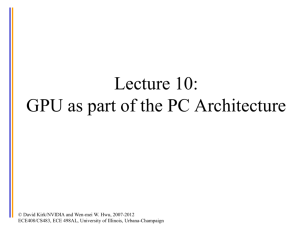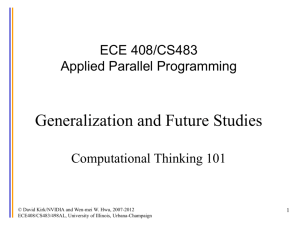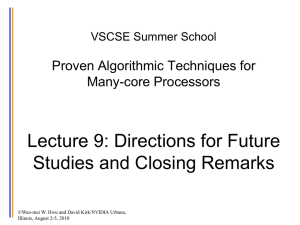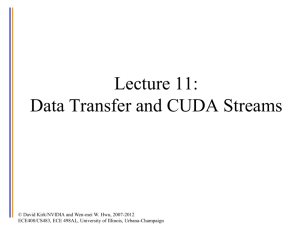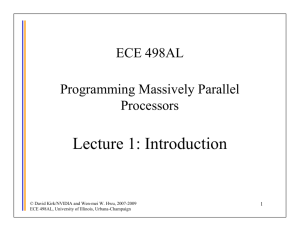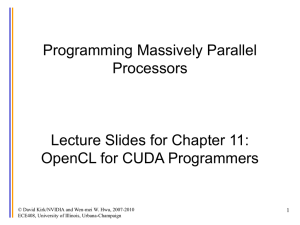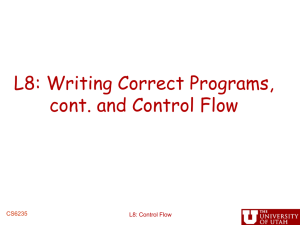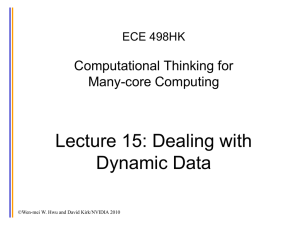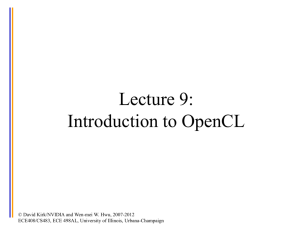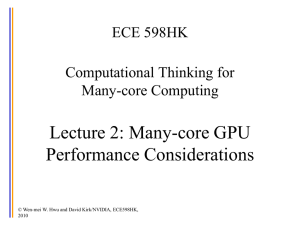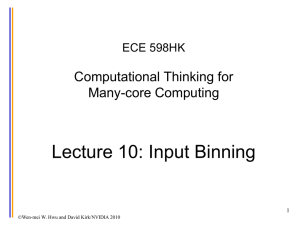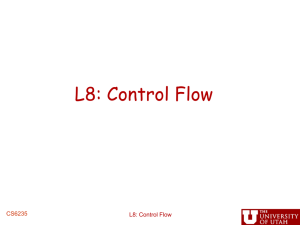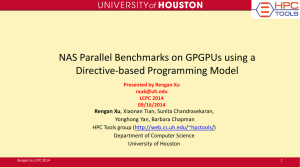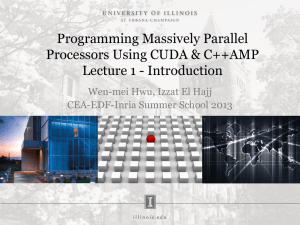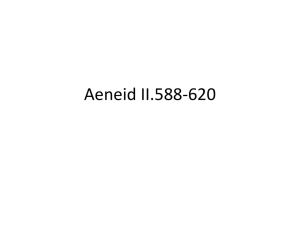ECE 498AL Lecture 4: GPU as part of the PC Architecture
advertisement
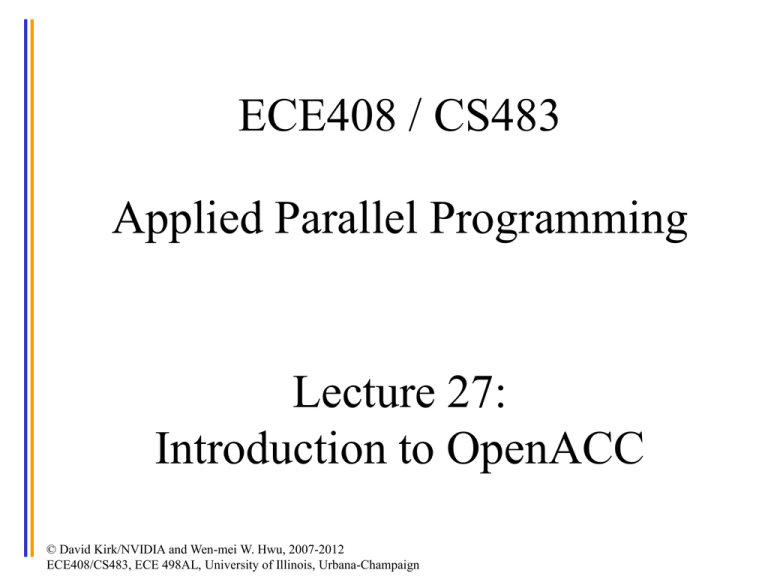
ECE408 / CS483
Applied Parallel Programming
Lecture 27:
Introduction to OpenACC
© David Kirk/NVIDIA and Wen-mei W. Hwu, 2007-2012
ECE408/CS483, ECE 498AL, University of Illinois, Urbana-Champaign
Objective
• To Understand the OpenACC programming
model
– basic concepts and pragmatypes
– Simple examples to illustrate basic concepts and
functionalities
© David Kirk/NVIDIA and Wen-mei W. Hwu, 2007-2012
ECE408/CS483, ECE 498AL, University of Illinois, Urbana-Champaign
OpenACC
• The OpenACC Application Programming
Interface provides a set of
– compiler directives (pragmas)
– library routines and
– environment variables
that can be used to write data parallel FORTRAN, C
and C++ programs that run on accelerator devices
including GPUs and CPUs
© David Kirk/NVIDIA and Wen-mei W. Hwu, 2007-2012
ECE408/CS483, ECE 498AL, University of Illinois, Urbana-Champaign
OpenACC Pragmas
• In C and C++, the #pragma directive is the
method to provide, to the compiler,
information that is not specified in the
standard language.
© David Kirk/NVIDIA and Wen-mei W. Hwu, 2007-2012
ECE408/CS483, ECE 498AL, University of Illinois, Urbana-Champaign
Simple Matrix-Matrix Multiplication in OpenACC
1 void computeAcc(float *P, const float *M, const float *N, int Mh, int Mw, int Nw)
2 {
3
4 #pragma acc parallel loop copyin(M[0:Mh*Mw]) copyin(N[0:Nw*Mw]) copyout(P[0:Mh*Nw])
5 for (int i=0; i<Mh; i++) {
6
#pragma acc loop
7
for (int j=0; j<Nw; j++) {
8
float sum = 0;
9
for (int k=0; k<Mw; k++) {
10
float a = M[i*Mw+k];
11
float b = N[k*Nw+j];
12
sum += a*b;
13
}
14
P[i*Nw+j] = sum;
15 }
16 }
17 }
© David Kirk/NVIDIA and Wen-mei W. Hwu, 2007-2012
ECE408/CS483, ECE 498AL, University of Illinois, Urbana-Champaign
Some Observations
• The code is almost identical to the sequential
version, except for the two lines with #pragma
at line 4 and line 6.
• OpenACC uses the compiler directive
mechanism to extend the base language.
–
#pragma at line 4 tells the compiler to generate code for the ‘i’ loop
at line 5 through 16 so that the loop iterations are executed in parallel
on the accelerator.
– The copyin clause and the copyout clause specify how the matrix data
should be transferred between the host and the accelerator. The
#pragma at line 6 instructs the compiler to map the inner ‘j’ loop to
the second level of parallelism on the accelerator.
© David Kirk/NVIDIA and Wen-mei W. Hwu, 2007-2012
ECE408/CS483, ECE 498AL, University of Illinois, Urbana-Champaign
Motivation
• OpenACC programmers can often start with
writing a sequential version and then annotate
their sequential program with OpenACC
directives.
– leave most of the details in generating a kernel
and data transfers to the OpenACC compiler.
• OpenACC code can be compiled by nonOpenACC compilers by ignoring the
pragmas.
© David Kirk/NVIDIA and Wen-mei W. Hwu, 2007-2012
ECE408/CS483, ECE 498AL, University of Illinois, Urbana-Champaign
Frequently Encountered Issues
• Some OpenACC pragmas are hints to the
OpenACC compiler, which may or may not
be able to act accordingly
– The performance of an OpenACC depends
heavily on the quality of the compiler.
– Much less so in CUDA or OpenCL
• Some OpenACC programs may behave
differently or even incorrectly if pragmas are
ignored
© David Kirk/NVIDIA and Wen-mei W. Hwu, 2007-2012
ECE408/CS483, ECE 498AL, University of Illinois, Urbana-Champaign
OpenACC Device Model
Currently OpenACC does not allow synchronization across threads.
© David Kirk/NVIDIA and Wen-mei W. Hwu, 2007-2012
ECE408/CS483, ECE 498AL, University of Illinois, Urbana-Champaign
OpenACC Execution Model
© David Kirk/NVIDIA and Wen-mei W. Hwu, 2007-2012
ECE408/CS483, ECE 498AL, University of Illinois, Urbana-Champaign
Parallel vs. Loop Constructs
#pragma acc parallel loop copyin(M[0:Mh*Mw]) copyin(N[0:Nw*Mw]) copyout(P[0:Mh*Nw])
for (int i=0; i<Mh; i++) {
…
}
is equivalent to:
#pragma acc parallel copyin(M[0:Mh*Mw]) copyin(N[0:Nw*Mw]) copyout(P[0:Mh*Nw])
{
#pragma acc loop
for (int i=0; i<Mh; i++) {
…
}
}
(a parallel region that consists of just a loop)
© David Kirk/NVIDIA and Wen-mei W. Hwu, 2007-2012
ECE408/CS483, ECE 498AL, University of Illinois, Urbana-Champaign
Parallel Construct
• A parallel construct is executed on an
accelerator
• One can specify the number of gangs and
number of works in each gang
#pragma acc parallel copyout(a) num_gangs(1024) num_workers(32)
{
a = 23;
}
1024*32 workers will be created. a=23 will be executed
redundantly by all 1024 gang leads
© David Kirk/NVIDIA and Wen-mei W. Hwu, 2007-2012
ECE408/CS483, ECE 498AL, University of Illinois, Urbana-Champaign
What does each “Gang Loop” do?
#pragma acc parallel num_gangs(1024) #pragma acc parallel num_gangs(1024)
{
{
for (int i=0; i<2048; i++) {
#pragma acc loop gang
…
for (int i=0; i<2048; i++) {
…
}
}
}
}
© David Kirk/NVIDIA and Wen-mei W. Hwu, 2007-2012
ECE408/CS483, ECE 498AL, University of Illinois, Urbana-Champaign
Worker Loop
#pragma acc parallel num_gangs(1024) num_workers(32)
{
#pragma acc loop gang
for (int i=0; i<2048; i++) {
#pragma acc loop worker
for (int j=0; j<512; j++) {
foo(i,j);
}
}
}
1024*32=32K workers will be created, each executing 1M/32K = 32 instance
of foo()
© David Kirk/NVIDIA and Wen-mei W. Hwu, 2007-2012
ECE408/CS483, ECE 498AL, University of Illinois, Urbana-Champaign
#pragma acc parallel num_gangs(32)
{
Statement 1; Statement 2;
#pragma acc loop gang
for (int i=0; i<n; i++) {
Statement 3; Statement 4;
• Statements 1 and 2 are
redundantly executed by 32
gangs
• The n for-loop iterations are
distributed to 32 gangs
}
Statement 5; Statement 6;
#pragma acc loop gang
for (int i=0; i<m; i++) {
Statement 7; Statement 8;
}
Statement 9;
if (condition)
Statement 10;
© David Kirk/NVIDIA and Wen-mei W. Hwu, 2007-2012
ECE408/CS483,
ECE 498AL, University of Illinois, Urbana-Champaign
}
Kernel Regions
#pragma acc kernels
{
#pragma acc loop num_gangs(1024)
for (int i=0; i<2048; i++) {
a[i] = b[i];
}
• Kernel constructs are
descriptive of
programmer
intentions
#pragma acc loop num_gangs(512)
for (int j=0; j<2048; j++) {
c[j] = a[j]*2;
}
for (int k=0; k<2048; k++) {
d[k] = c[k];
}
©}
David Kirk/NVIDIA and Wen-mei W. Hwu, 2007-2012
ECE408/CS483, ECE 498AL, University of Illinois, Urbana-Champaign
ANY MORE QUESTIONS?
READ CHAPTER 15
© David Kirk/NVIDIA and Wen-mei W. Hwu, 2007-2012
ECE408/CS483, ECE 498AL, University of Illinois, Urbana-Champaign
